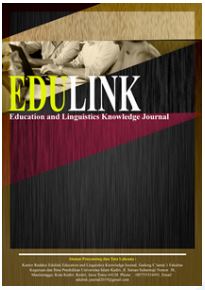Negative Transfer as Linguistic Challenges in Islamic Boarding School Students' Writing
Abstract
This research was motivated by a phenomenon of grammatical interference that occurred at the Islamic Boarding School using English students in daily conversation. The purpose of this research was to find out the form and factors of grammatical interference produced by students of Al-Madienah. This research used descriptive qualitative methods. Fifty-five resource persons were taken consisting of the students of 11th grade of Al-Madienah Islamic Boarding School. Data collection in this research was carried out in three ways: interviews, observation, and documentation. For the instruments used in data collection, there are three instruments, there are interview guides, observation checklists, and a list of documentation. Data analysis was carried out according to the theory of Miles and Hubermen (1992): data reduction, data display, and verification. The results of the data analysis are: 1) Pronouns and syntactic interference are the two types of grammatical interference in Al-Madienah. 2) Bilingualism and the decline in speakers' primary language are the two reasons that create grammatical interference. Grammatical interference always appears in communities that speak another language because bilingualism will happen when people speak in two languages or more and bilingualism is the big factor causing interference.
References
Angguni, R. (2020). Interlingual and intralingual errors of writing descriptive text made by third-semester students of English Education Department Sarjanawiyata Tamansiswa University Yogyakarta. JELLT (Journal of English Language and Language Teaching, 75-85.
Arikunto, S. (1998). Prosedur Penelitian – Suatu Pendekatan Praktek. Jakarta: PT. Rineka Cipta.
Arumi, S. &. (2020). Grammatical Language Transfer on English Caption in Instagram’s Hashtag# Englishexpounivet. Surakarta English and Literature Journal, 54-71.
Aziz, Z. A. (2019). Second Language Interference towards First Language Use of Japanese Learners. Indonesian Journal of English Language Teaching and Applied Linguistics, 159-176.
Bai, L. &. (2018). A study of negative language transfer in college students' writing from cultural perspective. Theory and Practice in Language Studies, 106-313.
Balenovic, K. (2017). Interlanguage Development in Early EFL Learning in Croatia: An Insight Into Individual Learner Profiles. Sino-US English Teaching. 436-445.
Bloomfield, L. (1995). Language – Bahasa. Jakarta: PT Gramedia Pustaka Utama.
Chaer, A. and Agustina, L. (2004). Sosiolingistik Perkenalan Awal. Jakarta: Rineka Cipta.
Depdiknas. (2006). Permendiknas No 22 Tahun 2006 Tentang Standar Isi. Jakarta :Depdiknas.
Fauzati, E. (2017). Native and target language influence on the students’ interlanguage production: a case of Indonesian EFL compositions. Indonesian Journal of Applied Linguistics, 64-63.
Fromkin, V. A. (2016). Errors in linguistic performance. New York: Academic Press.
Iman, T. R. (2020). The Interference of Indonesian on English Second Language Writing. Journal of Languages and Language Teaching, 170-182.
Inderasari E., &. A. (2017). Pembelajaran Bahasa Indonesia pada mahasiswa asing dalam program BIPA IAIN Surakarta. Jurnal Pendidikan Bahasa dan Sastra Indonesia, 6-15.
Jarvis, S. &. (2008). Crosslinguistic influence in language and cognition. Routledge.
J. Moleong, Lexy. 1989. Metodologi Penelitian Kualitatif. Bandung: Remadja Karya.
Jooh, D. (2019). Speaking A Sentence that Students Must Do in A Conversation. Journal International, 125-126.
Karimiabdolmaleki, M. (2022). Identifying Negative Language Transfer in the English Writing of Chinese and Farsi Native Speakers.
Karkafi, L. A. (2014). Negative language transfer: A study of essays by heritage and L2 students of Russian at the intermediate mid level of proficiency. Doctoral Dissertation UCLA.
Kumaran, P. N. (2021). The Influence of The Native Language on Second Language Writing (English). GEMA Online Journal of Language Studies.
Meriläinen, L. (2010). Language transfer in the written English of Finnish students. Itä: Suomen yliopisto.
Miles, B. Mathew dan Michael H. (1992). Analisis Data Kualitatif Buku Sumber Tentang Metode-metode Baru. Jakarta: UIP
Moleong, L. J. (2017). Metode Penelitian Kualitatif, Cetakan Ke-36. Bandung: PT. Remaja Rosdakarya Offset.
Permendiknas. (2006). No.23 tahun 2006 tentang Standar Kompetensi Lulusan untuk Satuan Pendidikan Dasar dan Menengah. Jakarta: Depdiknas.
Rahardi, K. (2001). Sosiolinguistik, Kode dan Alih Kode. Yogyakarta: Pustaka Pelajar (anggota IKAPI).
Sa'diyah, I. (2023). Variation of Syntax Errors and Causative Factors in Motivational Essays for Writing Training Participants. Nusantara Science and Technology Proceedings, 307-312.
Sari, S. S. (2021). Analysis on Negative Transfer of The Students' Writing Compositions. ResearchGate.
Sugiyono. (2008). Metode Penelitian Kuantitatif Kualitatif dan R&D. Bandung: ALFABETA.
Suwito. (1983). Pengantar Awal Sosiolinguistik Teori dan Praktik. Surakarta: Henary Offset.
Weinreich, U. (1968). Languages In Contact: Findings And Problems. New York: The Hague, Mouton.

This work is licensed under a Creative Commons Attribution 4.0 International License.
This work is licensed under a Creative Commons Attribution License























 This work is licensed under a
This work is licensed under a  https://orcid.org/0000-0001-9166-6040
https://orcid.org/0000-0001-9166-6040
